Can scientists wake up sleeping tumor suppressor molecules in cancer cells? What are the genetic features of cancer cells that contribute to some forms of prostate cancer developing resistance to multiple lines of treatment?
Those were some of the topics covered at UNC Lineberger Comprehensive Cancer Center’s 43rd Annual Scientific Symposium at the William & Ida Friday Center for Continuing Education in Chapel Hill. More than 500 people registered for the meeting, which featured talks on cancer signaling from scientists from around the nation.
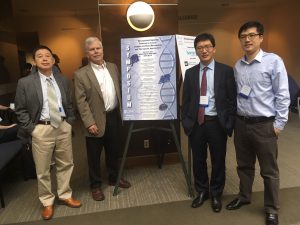
“We heard about new science into the initiation events that can cause cancer, steps we might take to potentially prevent the disease, and into development of molecularly-targeted small drugs for cancer treatment,” said UNC Lineberger’s G. Greg Wang, PhD, associate professor in the UNC School of Medicine Department of Biochemistry & Biophysics and a co-organizer of the symposium. “It covered a lot of bases, and was quite exciting.”
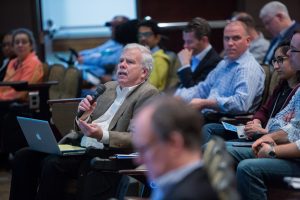
UNC Lineberger launched the scientific meeting in 1977, said UNC Lineberger’s Al Baldwin, PhD, associate director for basic research and one of the symposium-co-organizers, just a few years after the cancer center was established. This year’s event included speakers who covered a wide range of topics, including talks by three recipients of the Lasker Award, one of the most prestigious honors presented to those have made major advances in the understanding, prevention or treatment of disease.
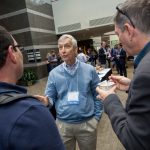
One series of talks focused on cancer and epigenetics, which is a field of research that deals with how the genetic code canimproperly unraveled, sometimes exposing genes aberrantly that can drive cancer. Rockefeller University’s C. David Allis, PhD, presented a Lineberger lecture on problems that can occur in the coding of histones, tiny proteins that act as spools for threads of DNA. Allis said minor amounts of “bum histones” can become part of a faulty structures that can lead to inactivation of genes, leading to a sometimes deadly impact.
“Many more patient mutations are being identified in histone genes,” he said. “It’s a completely fair (question) whether these new mutations are passengers or drivers.”
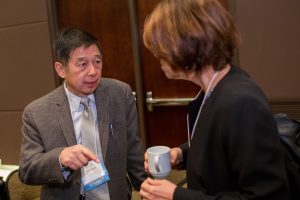
UNC Lineberger’s Yue Xiong, PhD, the William R. Kenan Jr. Professor of Biochemistry and Biophysics and another co-organizer, presented research into the impacts of defects in TET, a molecule that normally helps to prevent cancer. One specific molecule, TET2, helps to activate genes used to generate signals that help recruit cancer-fighting immune cells. In cancer cells in which it’s mutated, Xiong said TET2 isn’t dead, it’s a “sleeping horse.”
“Can we wake it up?” he said.
Xiong presented findings from a preclinical study that investigated whether they could use vitamin C to wake up the “sleeping” TET2 molecule. They found vitamin C could stimulate this tumor suppressor in mouse models, but it required levels too high for humans “no matter how much orange juice you drink.” Xiong said his laboratory is exploring other avenues involving TET to boost responses to immunotherapies.
In another talk, Wang spoke about a genetic error found in 20 to 30 percent of cases of acute myeloid leukemia. Errors in the code for the DNMT3A protein can lead to over production of undeveloped blood cells, he said, rather than allowing them to become mature, differentiated blood cells. Ultimately, Wang said the goal of this work is better treatment.
“If we are able to understand the mechanism, we can develop treatments,” he said.
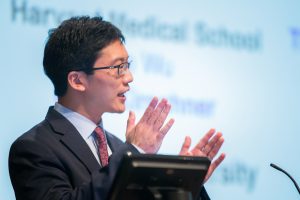
UNC Lineberger’s Qing Zhang, PhD, an associate professor in the UNC School of Medicine Department ofLaboratory and Pathology Medicine, discussed how a genetic alteration in patients with kidney cancer can lead to drive cancerous growth. Zhang’s research has identified potential new therapeutic target for patients who have lost the tumor suppressor VHL.
“We study von Hippel-Lindau tumor suppressor pathways, which are lost or dysregulated in kidney cancer,” Zhang said. “These are cellular signals that help sense oxygen in cells, and we’ve identified key players that we hope will lead to novel therapeutic avenues that could beneficial to kidney cancer patients, or in a broader view, other patients as well.”
Charles Sawyers, MD, chair of the Human Oncology and Pathogenesis Program at Memorial Sloan Kettering Cancer Center and a member of the board of Novartis, spoke about new research into how prostate cancer cells can “shift their identity” as they develop resistance to treatment. Sawyers, whose talk was designated as a Lineberger lecture, described how gene expression within prostate cancer cells can shift to result in a change in identity.
“I’ve become fascinated by this problem, which I think is growing in frequency…,” he said, as scientists are “making better and better inhibitors.”
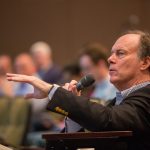
William G. Kaelin Jr., MD, of the Dana-Farber Cancer Institute delivered the symposium’s first Lineberger lecture.
He left a powerful message for the scientists in the audience in closing, saying that if their motivation is in pursuit of “fame, fortune and fooling reviewer three, but not paying attention to reproducibility and robustness….please step out of the way.”
Our children are “going to be counting on the science we’re doing now,” Kaelin said.
A full list of speakers and presentations is available online.
